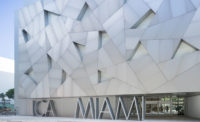A little more than a year after its splashy debut, the new harbor-side home of Boston’s Institute of Contemporary Art (ICA), designed by Diller Scofidio + Renfro, is looking less than watertight. Museum-goers this winter have observed leaks along the ceiling of the building’s top level where it joins the glazing of the curtain wall, and buckling of stucco under an exterior stair adjacent to the main entrance.
All buildings experience settling-in periods and require adjustments of one sort or another, and high profile buildings attract more scrutiny. But the ICA’s construction involved some bad luck, including the demise of its first construction firm, which contributed to delaying the building’s 2006 opening by several months. Experts note that the innovative design—the structure features a dramatically cantilevered gallery level—was challenging to build and that the unforeseen change in contractors complicated matters.
The ICA’s first contractor, George B.H. Macomber, went out of business during the project. Skanska USA took over when the building was roughly 70 percent complete and finished the job.
ICA officials acknowledge some problems with the stucco exterior, and floor finishes inside, but decline to elaborate on them or the leaks. “It was a difficult design, a one-of-a kind building, and we are thrilled to have delivered it,” says Donna Desrochers, the ICA’s director of marketing and communications. “It’s been a joy to see the cantilever become a magnet for visitors.”
For its part, Skanska was not aware of any remediation plans as of late February, according to spokesperson Jessica Murray.
The ICA has had to wrestle with slipped schedules and less than perfect finishes, Desrochers admits. “We would have liked the finish on our floors to be more consistent, but the floors are highly functional. The glass door designed for the elevator was not installed in time for the opening. It will be installed in March,” she says. “As for the stucco, we could tell when it was applied that it would need to be replaced, and we did that this past fall. We think our building is operating well. Like any new building, it’s taken about a year to settle in, but the core design features are fantastic.”
The ICA recently paid Macomber a reported $2.2 million to settle a suit over change orders and “extra” work. The suit stemmed from wrangling over scheduling and contract details, some related to change orders, according to local press reports. Macomber’s suit also cited unspecified design issues.
“We are pleased with the settlement, and we are focusing our energy on making the most of this wonderful building, and on building our audience,” Desrochers says. “We have now been in the new building for 14 months and we couldn’t be happier with what it’s done for the ICA. The response in the community has been overwhelmingly positive, with more than 300,000 visitors in our first year.”
The building’s cantilevered design, and the challenge of applying sheet metal, concrete, plaster and stucco with a high degree of finish, would test contractors accustomed to more conventional blueprints. The disruption in construction and changes in the project team added to the challenge.
“Museums are complicated projects to begin with and when circumstances require that the team change midstream it’s a very risky thing,” says Séamus Henchy, whose firm Séamus Henchy and Associates managed the project until Skanska took over both project management and construction following Macomber’s departure. “There’s a huge catch-up period, but in reality you never actually do catch up.”
The project involved an unusual number of change orders, Henchy continues, possibly as a result of the ambitious design, which may have been more exacting than Macomber realized when bidding on the job.
Whether as a result of the change in contractors, time pressures, or other difficulties, Henchy says, the finished product is “a little disappointing. The design is wonderful. It takes full advantage of the site and technologies, but the last push probably fell short a little bit. The fit and finish I think don’t quite do it justice. When you’re doing something as creative [as the ICA], when it’s outside-the-box construction, the bar is raised automatically.”
Despite its construction woes, the building won a 2007 New York AIA Honor Award. The ICA was the first major design of Manhattan-based Diller Scofidio + Renfro to be built in North America. The firm has used a similar cantilever structure for the Juilliard School of Music as part of its ongoing redevelopment of Lincoln Center.







Post a comment to this article
Report Abusive Comment